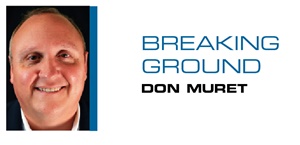The group responsible for redeveloping
Daytona International Speedway has brought new technology to the field to enable the renovation to be completed in three years.
Under the design-build agreement with track owner International Speedway Corp., construction firm Barton Malow holds the contract for the $400 million Daytona Rising project. Sports architect Rossetti fills the role as the builder’s subcontractor.
The relationship is geared to streamline the process of completing the massive job in 36 months while the track remains in operation. The two firms and other subcontractors work hand-in-glove at their temporary office compound a half-mile from the speedway.
Inside those trailers, tasks are performed on 56-inch interactive Smart Board flat-panel displays. In a mostly paperless environment, the size of those flat-screens simulates the large architectural drawings typical for designers and builders.
 |
The project office is filled with interactive flat-screen displays.
Photo by: DON MURET / STAFF
|
They’re using the newest techniques tied to building information modeling, or BIM, a three-dimensional design system that’s existed for more than 30 years and has been refined and improved through advances in technology.
As the main grandstand is rebuilt, Rossetti runs its own proprietary software program called Sightline Designer to evaluate and adjust sight lines that vary in height because of the curvature of the earth along the 4,000-foot-long structure.
At the track and outside of Daytona Beach, Barton Malow superintendents and ISC officials working on the project have their own iPads connected to the same software programs that their counterparts are working on in the trailers. Everybody is on the same page, leading to quicker decisions on the spot. For some Barton Malow workers in the field, using tablets on the job is a new experience and their education starts with how to turn on the mobile device, said Jason McFadden, the firm’s project manager for Daytona Rising.
“It’s a vital tool,” McFadden said. “It’s more important to them now than a hammer and screwdriver and tape measure used to be.”
At the same time, Rossetti has created 3-D images on iPads that ISC’s marketing department is using to sell hospitality space for next year’s events. They are loaded with renderings and videos to make it easier for ISC by giving its sponsors a better sense ahead of time for what those areas could look like.
Establishing a seamless mode of communication in real time among multiple stakeholders is something Rossetti officials believe is cutting edge in sports development, said Jim Renne, a principal with the firm.
“We’ll do this from our office [in Detroit], but usually the client on the other end doesn’t have this technology,” Renne said. “To see our building partner have this [too] brings it to another level. We’re expediting communication.”
The project comes to a close in January. Without new technology in place, it could have taken closer to five years to finish, Renne said.
> WILD THING: Tampa Bay Lightning executives returned to their roots in Minnesota for upgrades to Amalie Arena.
The new loge boxes in the north end of Amalie Arena, formerly the Tampa Bay Times Forum, were inspired by a similar retrofit a few years ago at Xcel Energy Center in St. Paul.
For next season, the Lightning is replacing about 360 regular seats with four- and six-person loge boxes. The four tiers of 140 to 160 seats start at $50,000 a season for a four-person unit, team officials said.
Tampa Bay CEO Tod Lewieke and team President Steve Griggs were both on the front end of developing the Wild’s arena, which opened in 2000. In addition, Griggs worked on the marketing side for the Orlando Magic at Amway Center, a 5-year-old arena with about 330 loge box seats.
Generator Studio, led by founder Tom Proebstle, a Minnesota native, designed the loge boxes at both Amalie Arena and Xcel Energy Center.
In Tampa, the loge boxes are part of $25 million in upgrades, a cost shared equally between the Lightning and Hillsborough County.
Don Muret can be reached at dmuret@sportsbusinessjournal.com. Follow him on Twitter @breakground.





